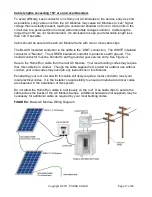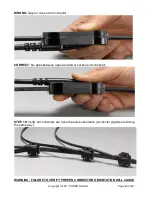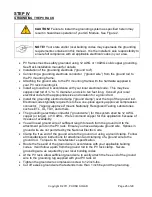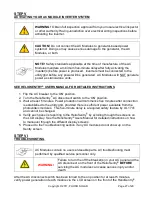
Copyright © 2011, PHONO SOLAR
Page 12 of 29
STEP I
INSTALLING THE PV RACKING SYSTEM
NOTE:
REFER TO THE PV RACKING INSTALLATION MANUAL FOR ALL MOUNTING
INSTRUCTIONS AND CALCULATIONS. THE MANUAL IS LOCATED IN THE RACKING
SYSTEM PACKING.
SELECTING A MOUNTING LOCATION
When choosing your PV mounting location:
Choose a location with minimal shading. An ideal solar array location with have little
to no shade from 9:00am to 3:00pm.
The AC module must face south in the northern part of the earth and face north in the
southern part of the earth.
Array tilt. Follow the slope of your roof.
Commercial rack systems are recommended for flat roof tops. Commercial rack
systems are designed with specific tilts for your location.
Choose a location near your utility interface (AC breaker panel). Remember, the
maximum Home Run cable is 100 ft. in length. Ten is the maximum number
of inverters per run of cable no matter what length of cable you are using. This is a
limit imposed by the National Electric Code based on the size of the wires in the
cable and the inverter's maximum output current rating. It relates to the energy loss in
the wire compared to the length of the wire. The installer would need to perform a
calculation to determine the number of inverters versus the total cable length.
The AC Module may be mounted in any orientation. (See Figure 2)
The location selected must comply with the National Electric Code and your local
safety and building codes.
Verify the roof is in good condition before mounting the PV rack system.
NOTE!
The installer is solely responsible for:
1) Complying with all applicable local or national building codes, including
any that may supersede this manual;
2) Ensuring that the roof, its rafters, connections, and other structural
support members can support the array under all code-level loading
conditions;
3) Using only those parts supplied with the mounting kits for mounting and
attachment of the AC Modules to the rack frames;
4) Ensuring that lag screws have adequate pull-out strength and shear
capacities as installed (See rack installation manual for details);
5) Maintaining the waterproof integrity of the roof, including selection of
appropriate flashing;
6) Ensuring safe installation of all electrical aspects of the AC Module
array; and
7) Ensuring correct and appropriate design parameters are used in
determining the design loading used for design of the specific
installation. Parameters such as snow loading, wind speed, exposure
and topographic factors should be confirmed with a local building













































